
The only caveat was that e-ink could not display color content. But this was presented as a feature, not a disadvantage. Like, reading from color screens of smartphones and tablets is harmful, read better from paper-like displays E Ink. And these displays are only in readers. So buy readers! On the one hand, readers cannot show a color picture, a big problem! Anyway, we mostly read black letters on a light background. On the other hand, sometimes we come across picture books. And in this case, color support, if not required, is highly desirable. That is why the creators of electronic paper have worked for a long time to release a color matrix. And released last year - E Ink Kaleido. This is what can be called the main revolution in 15 years of development of readers as a class of devices. To be absolutely precise, the E Ink color screens existed before, but did not get widespread. Therefore, it is Kaleido that can be considered the first mass-produced E Ink color screen.
The first manufacturer to introduce the new E Ink color matrix was PocketBook. This is not surprising, since PocketBook is the largest player in the e-reader market in Russia. This means that it is up to him to "bear the burden" of a technological leader. The pioneer was the PocketBook 633 Color model. It was noticeably different from a few competitors for the better, because the screen was installed in it not "as is", but optimized and tuned. PocketBook engineers worked on it together with E Ink specialists. As a result, the image turned out to be slightly richer than that of competitors.
PocketBook 633 Color was produced in the classic format for E Ink readers - with a 6-inch screen. This is ideal for most - neither big nor small. However, at 6 inches it is convenient to read only children's picture books. But if you read comics, full-length magazines, business documentation with graphs or diagrams, textbooks, then you need a larger screen so that you do not have to frequently scale the image. Constantly pinching and spreading your fingers while reading is not very convenient.
That is why, in 2021, PocketBook released the new PocketBook 740 Color - the world's first electronic reader with a 7.8-inch E Ink Kaleido color screen. That is, it is noticeably larger than that of the 633 Color.
I have seen both models - 740 Color and 633 Color. Below I will briefly compare them, but I will pay special attention to the older 7.8-inch model. And here, for starters, I will say that after PocketBook 740 Color you no longer want to take ordinary black-and-white readers in hand - the color model gives a completely new user experience.
Specifications PocketBook 740 Color
- Dimensions: 195 x 136.5 x 8mm
- Weight: 225g
- Screen: E Ink new Kaleido, diagonal 7.8 inches, 1872 × 1404 (E Ink Kaleido Plus), 4096 colors, touch, with backlight
- Processor: Allwinner B288 1GHz x 2 (dual core)
- Memory: operational - 1 GB, internal - 16 GB
- Wireless interfaces: Wi-Fi 802 b / g / n, Bluetooth
- Ports: USB Type-C, microSD (up to 32 GB)
- Operating system: proprietary PocketBook based on Linux
- Supported formats: ACSM, CBR, CBZ, CHM, DJVU, DOC, DOCX, EPUB, EPUB (DRM), FB2, FB2.ZIP, HTM, HTML, MOBI, PDF, PDF (DRM), PRC, RTF, TXT
- Battery: Li-Ion, 3.7 V, 2900 mAh, up to 25,000 pages without backlight
Equipment
In the box, in addition to the e-book itself, you will find a USB Type-C cable, a USB Type-C to 3.5 mm adapter for connecting ordinary headphones, a brief instruction and a warranty card.

Design
PocketBook 740 Color has a restrained recognizable design. The reader looks elegant and solid. Made of durable matte plastic, resistant to scratches and fingerprints. The body color is silvery, the shade is pleasant. The assembly is monolithic.

You might think that a reader with an oversized screen would be too big, but not. The diagonal is 7.8 inches, but the bezels around the display are narrow. The difference in the diagonal of the 6-inch screen is very noticeable, but the reader cannot be called a "shovel", it is not bulky, it is quite convenient to hold it with one hand. This is also facilitated by the low weight - only 220 grams. There are 6-inch readers on the market with almost the same weight.
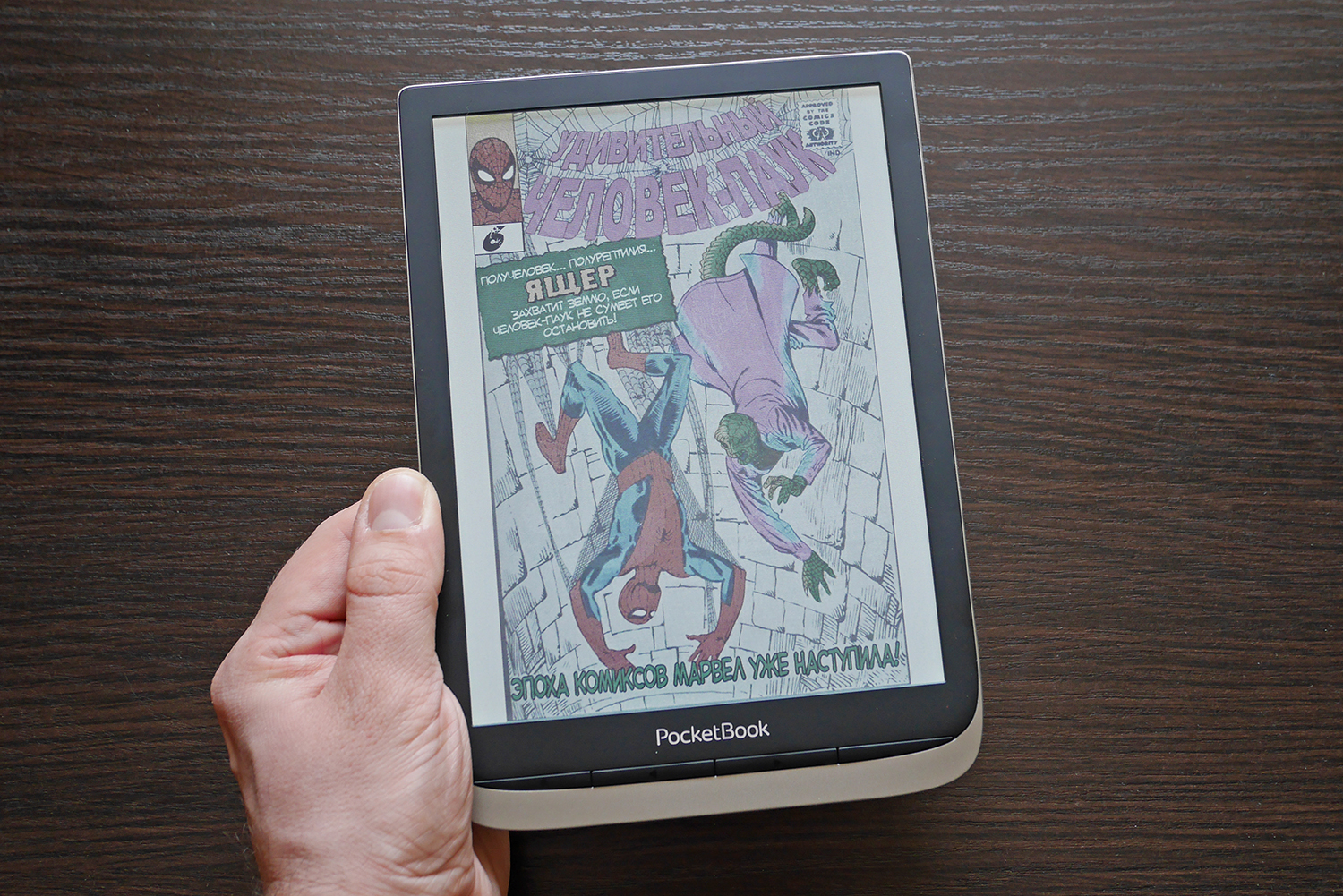
The display is somewhat recessed into the body. This is done on purpose - if the device falls or is left somewhere with the screen down, it is unlikely to be damaged. The screen is protected by glass. Gone are the days when E Ink readers were extremely fragile. Although, if you regularly take the reader with you somewhere, it is better to get a case.

On the front panel under the manufacturer's logo there are control keys - "home", menu, scrolling. A lot of reader manufacturers, having switched to touch screens, have abandoned the keys. And in vain, because there are many people who find it more convenient to scroll or return to the desktop with the keys. The buttons are of a good size (in the photo they seem narrow, but in reality there are no inconveniences), they have a clear movement. And the keys can be very flexibly configured to call up various functions.

On the bottom end of the PocketBook 740 Color case there is an on / off button (has a switchable white backlight), slots for memory cards and charging / data transfer. I am glad that this model uses the modern USB Type-C port format. After all, many readers are stuck in the past with antediluvian MicroUSB.

Screen
Let's talk about the most interesting part of PocketBook 740 Color - the color screen. E Ink is fundamentally different from LCD screens in that it literally contains ink. They are enclosed in miniature capsules and, thanks to the laws of physics, form an image. At the same time, they do not glow like liquid crystals, so there is no load on the eyes, flicker. Electronic ink on the example of the Kaleido screen does not display color by itself, but thanks to a color filter superimposed on top.
Moreover, in 2020, this filter was still not very perfect, some criticized the image for haze, and the screen substrate for a gray tint. However, the 6-inch readers had the first version of Kaleido, while PocketBook 740 Color had the second. It is called E Ink New Kaleido or E Ink Kaleido Plus. In this version, the problem of "grayish-hazy" has been fixed. Now the picture is almost as perfect as that of the classic E Ink Carta. But, of course, not black and white, but color.
The difference between E Ink Kaleido and E Ink new Kaleido is clearly visible in this picture:
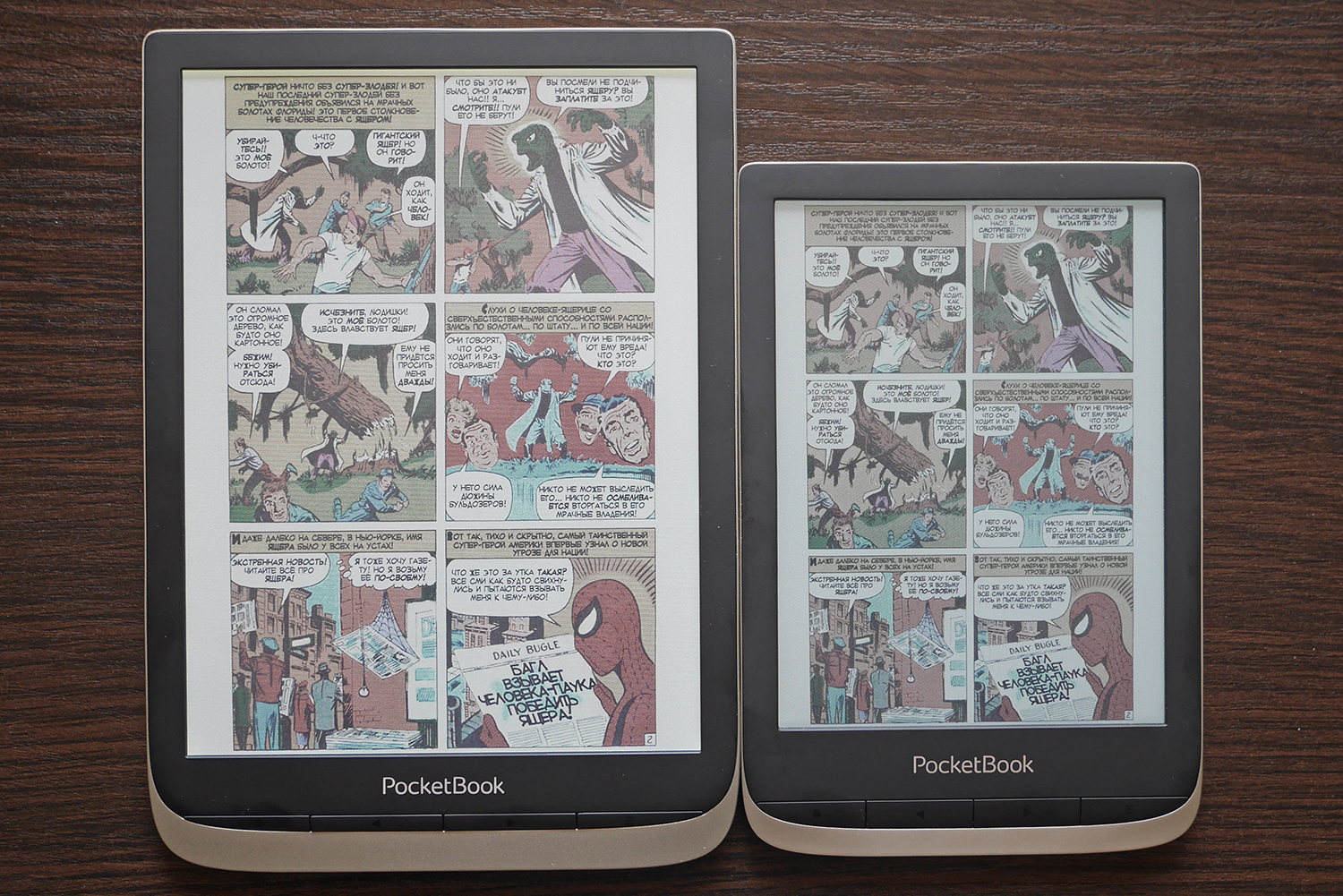
PocketBook 740 Color (left) and PocketBook 633 Color
And here is the crop from it. It is very clear that the 6-inch screen still does not provide the necessary clarity when reading the same comics. The letters are small and blurry. But on the 7.8-inch display, everything is already good. Plus, again, the colors are much nicer.
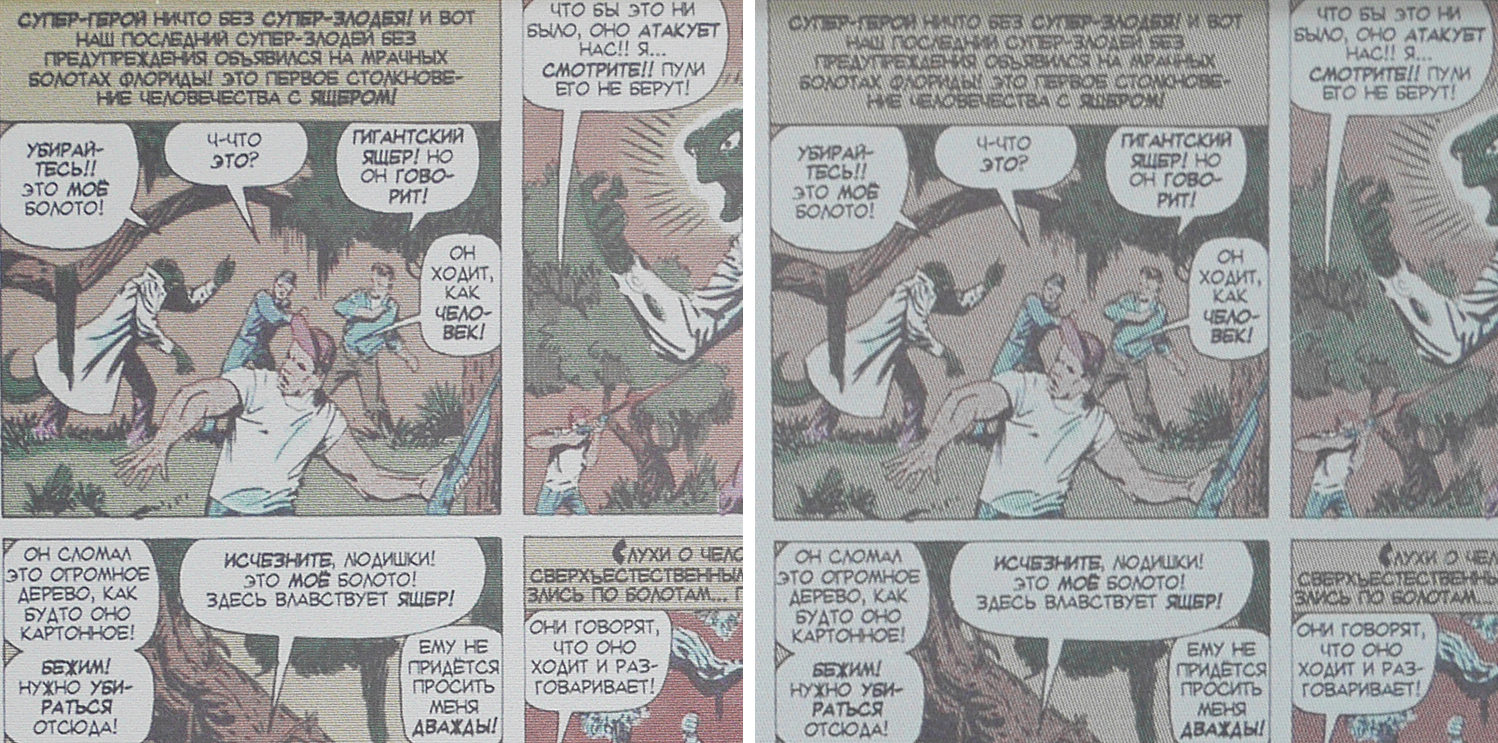
PocketBook 740 Color (left) and PocketBook 633 Color
Here is a similar pair of frames with a business document.

The bottom line is the same: this document is comfortable to read on a 7.8-inch color reader with Kaleido, but not on a 6-inch one.

PocketBook 740 Color (left) and PocketBook 633 Color
If we compare it with a black-and-white reader, the result will be like this. Colored is preferred.

PocketBook 740 Color (left) and PocketBook 633 Color
And so I also took such a photo - the textbook was not at hand, but a picture from a certain textbook on biology was found. It seems to me that it is pointless to study this on a black and white screen, you need a color one.

PocketBook 740 Color (left) and PocketBook 633 Color
I have already mentioned that they do not take the "stock" version of E Ink matrices in PocketBook, but optimize the picture. Therefore, the image is clearer than that of competitors, the color reproduction is better. There is one more thing - screen grades. It's like eggs - there is the first grade, there is the second, there is the third. PocketBook receives only the highest grade screens from E Ink. Other manufacturers, as a rule, get matrices with some defects. Yes, even if most users do not notice this, the fact remains.
At the same time, you do not need to think that a color electronic reader will give you a picture like a smartphone or tablet, displaying millions of shades. This is a different technology. I would say that the image is like in a colored newspaper with good printing. Color content has a slightly lower resolution due to the filter's peculiarities, it is not as clear as black and white text. But all this is not important, because the main task - the perception of colored content - is being fulfilled. If you read educational literature, reports with graphs and charts, children's books or comics, you are not so worried about the richness and richness of colors. First of all, it is important that we have before us the same E Ink, which imitates a printed page. This means it is absolutely harmless to sight.

Of course, you can read on a tablet, on a phone, and even on a computer monitor, but the sensations will be completely different. LCD displays glare in light, fade in the sun. And the worst thing is their flickering. You may not even notice this PWM, but if you measure it with a special device, then depending on the model, the flicker may be excessive. As a result, tired, watery eyes, in theory, "shrunken" vision.
For E Ink readers, the screens themselves do not light up. Backlighting is added to them additionally, it is lateral, does not "hit" in the eyes and does not bother. Note that there are no options for adjusting the color temperature of the backlight for PocketBook 740 Color. And this is understandable - changing the hue of the backlight will affect the display of colored content and distort the color rendition that E Ink Kaleido has, let's face it, and so imperfect. So I don't write down this moment as a disadvantage.
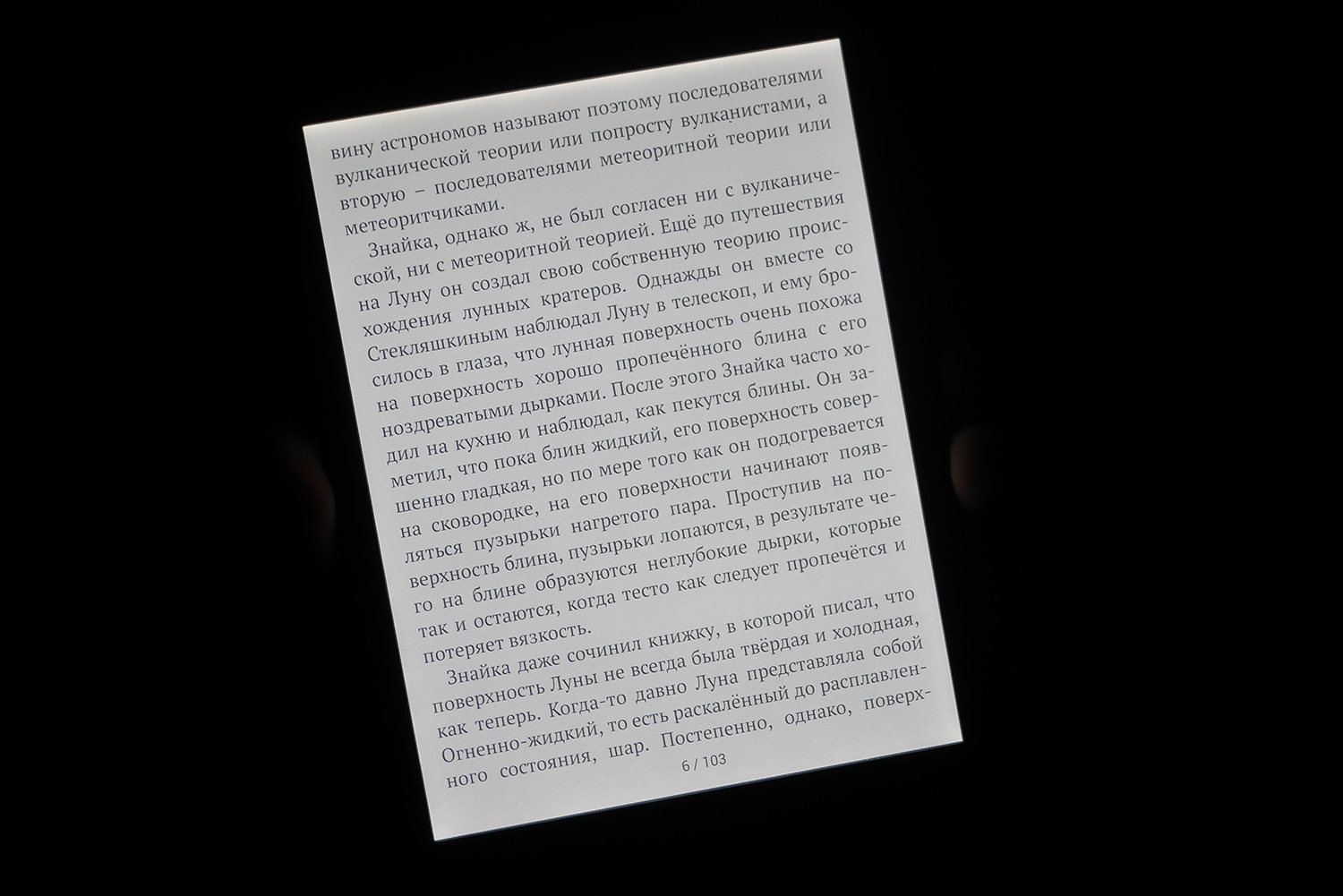
During the test, I did not use backlighting during the day in good lighting, if I was reading black and white text. But for a color image, it's still better to turn it on, the colors will be more juicy. However, in the PocketBook it was foreseen and a high-capacity battery was installed in the color 740th model.
"Iron"
PocketBook 740 Color is powered by a 2-core processor with 1 GB of RAM. For a modern smartphone, this is clearly not enough, but for an electronic reader based on the Linux operating system, it is already quite enough for it to work with lightning speed (given the features of E Ink, which itself does not reload instantly).
It takes a couple of seconds to open an ordinary book for the first time, if a "heavy" PDF weighing 200-300 MB - up to 3-4 seconds. Turning the page takes a split second. It takes about a second or two to get out of sleep, and about 7 seconds to fully turn on. All this is due to the Linux-based operating system. Competitors with Android are much more thoughtful (they only turn on for half a minute, they can open a large file for 10-15 seconds), they actively "eat" the battery in standby mode (2-4% per day) - and all this despite the fact that the processors in Android readers are used, as a rule, 4-core.
Built-in memory of PocketBook 740 Color - 16 GB. This is enough for 30 thousand books in text formats and dozens of audiobooks. If desired, you can always connect a memory card.
Software
Installed its own PocketBook OS based on Linux. Not only nimble, but also comfortable. The firmware version specifically for PocketBook 740 Color is 6.1, the design elements were updated in it, the order of the icons in the menu was changed, and the charge display was added to the status bar. It began to look fresher and more modern. Pocketbooks traditionally have well-thought-out software. Not only a library and reading, like the competitors, but a developed OS. A full desktop, a status bar, a "curtain" with shortcuts, applications (including games, drawing, RSS reader, calculator, email client, notes) ...
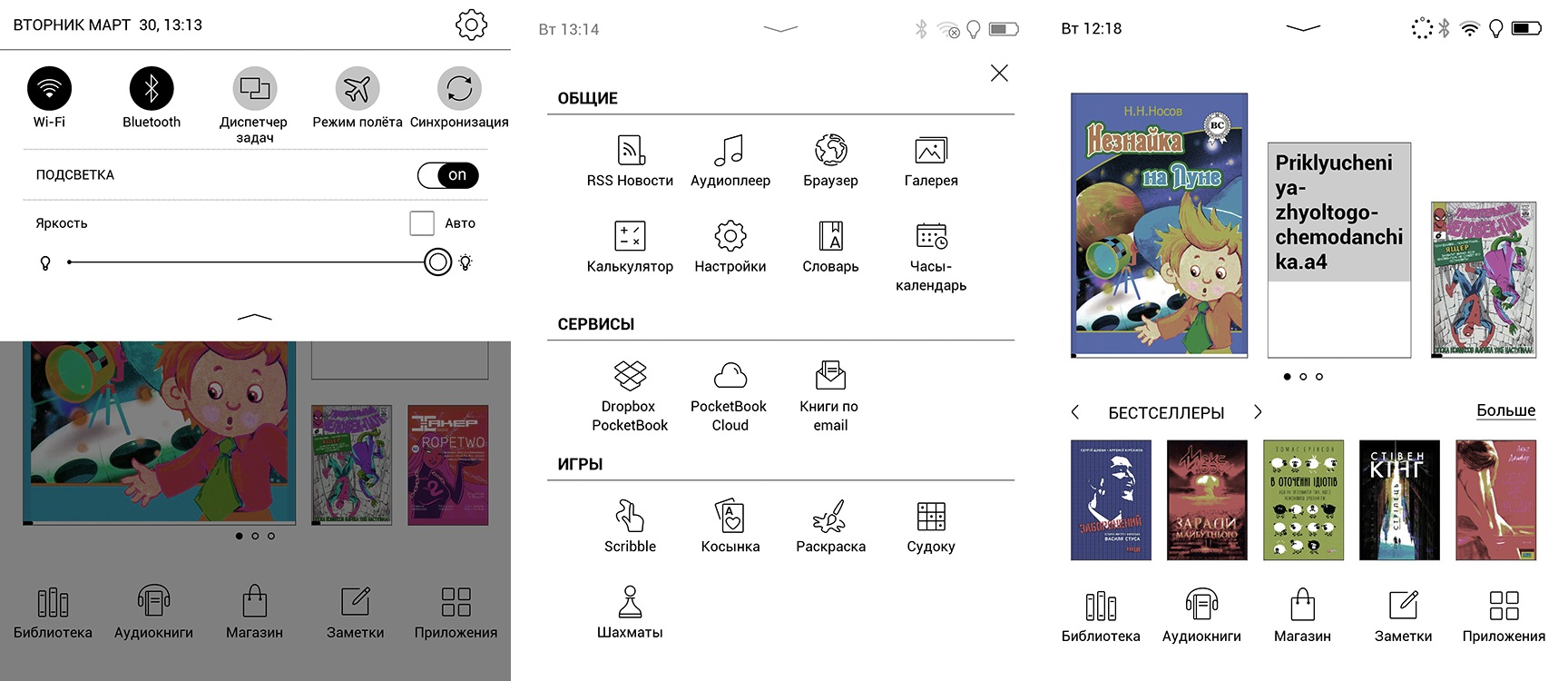
The home screen displays the most recently opened books, you can swipe to the left to see more covers, including lists of added books. At the bottom of the screen are recommendations from the PocketBook branded bookstore.
When reading, there are many settings available for the design of the text, you can change everything to your taste and beyond recognition.
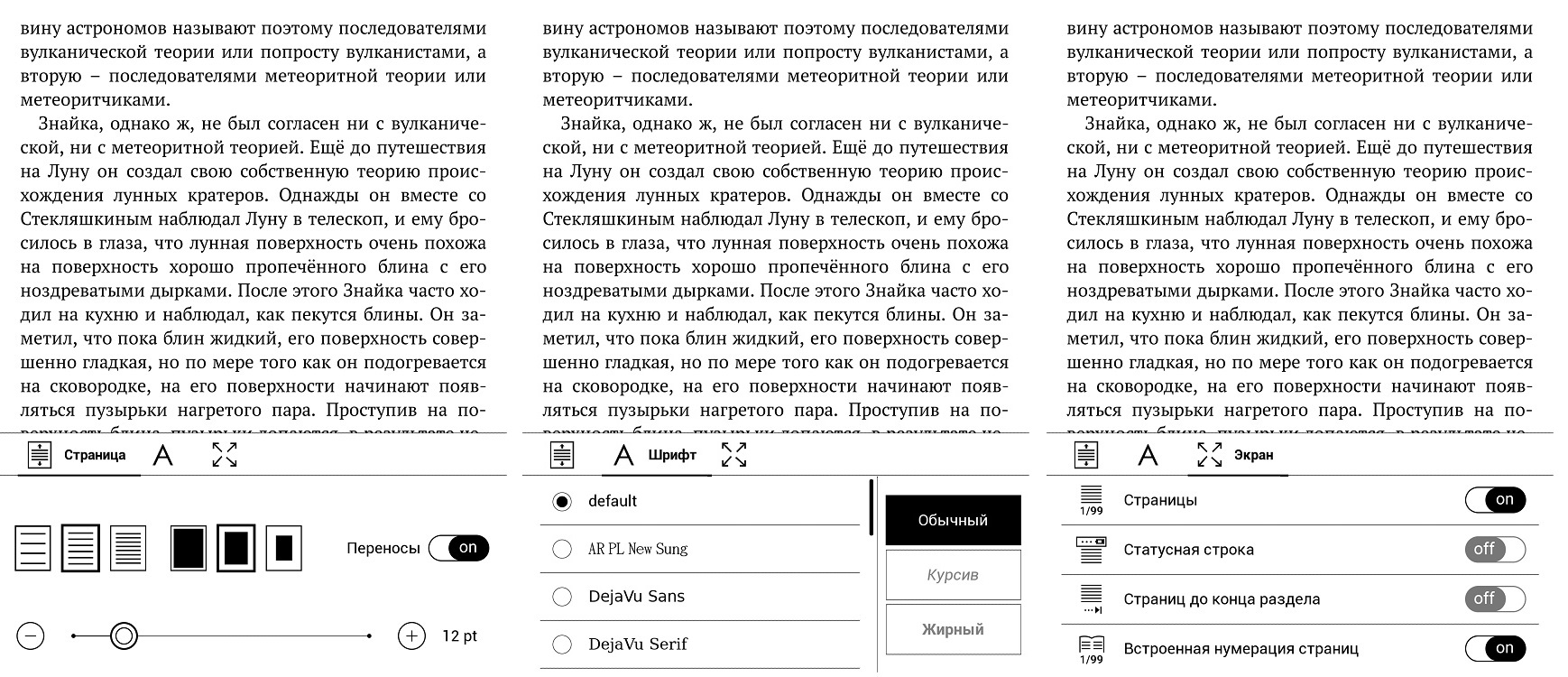
The library is convenient with various possibilities for cataloging books / sorting files.
I think everyone is interested in what happened to the PocketBook interface with a color screen. Nothing special has become. In my opinion, it makes no sense to paint each element like a Christmas tree. Color is used only where it is needed. For example, when selecting text with different "markers". Or in applications - Scribble (drawing), coloring. The photos in the gallery are of course also displayed in color.
Reading
Pocketbooks are traditionally omnivorous (20 formats). It is unlikely that you will find a text format that they do not know. The file system is open, you can upload files to any folder or to the root directory. Although today the transmission of books by cable is already "the last century." So PocketBook 740 Color, like other models of the company, has Wi-Fi and support for the Dropbox cloud service and its own PocketBook Cloud. If you use the PocketBook application on your smartphone, it will allow you to synchronize the process of reading one book both on the reader and on the phone. Books can also be sent to the reader by email.
And, of course, books can be purchased from the built-in bookstore. In 2021, PocketBook launched a new version of their store, which is also available at books.pocketbook.ru. All files are checked there and will display perfectly. And the prices are the same as in other popular online stores like Liters.
Those who study foreign languages will be pleased with the built-in dictionaries. The implementation is convenient - highlight the word while reading and see the translation in a separate window. Dictionaries can be added if you find compatible ones on the network or download them from the PocketBook website.

Of the interesting chips - an RSS reader, as well as saving the page in the browser in the form of books. You can write down the "longreads" you are interested in in this way and then calmly and without straining your eyes read where there is no Internet (train, plane).
Not all pocketbooks have support for audio files, but top models, including PocketBook 740 Color, cannot do without it. Supported formats are MP3, M4A, M4B, OGG, OGG.ZIP, MP3.ZIP. Why is this necessary if it is more convenient to listen to music from a smartphone? Not for music, but primarily for audiobooks - there is a handy application with chapters and read speed adjustment. You can also read and listen to a book in a foreign language at the same time. It is an effective language learning technique.
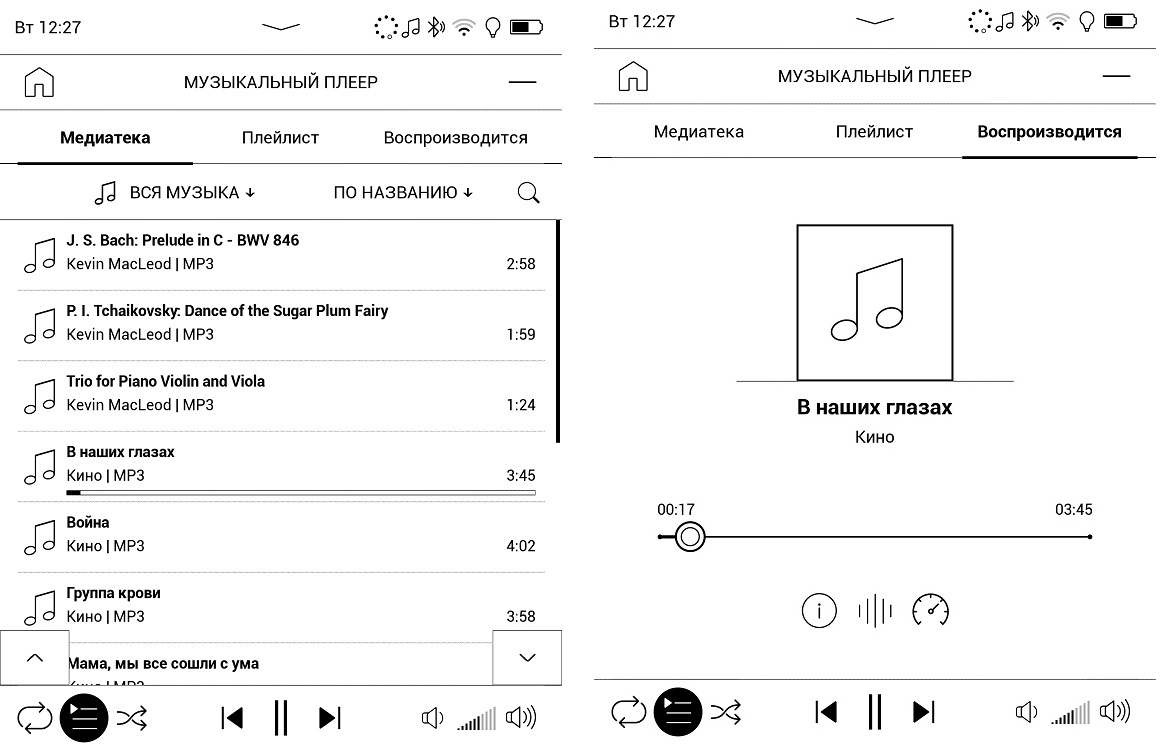
In addition, PocketBook 740 Color has a Text-to-Speech option. It allows you to turn a text book into an audiobook completely free of charge. If a few years ago machine reading was imperfect, now it is listenable. Yes, there may be hesitation or incorrect stress (the second, by the way, is a feature of the great and powerful Russian language, in many foreign languages there is no such problem), but not critical. Convenient in the car, for example, or even at home if you are doing business. The reading speed changes, you can choose a male or female voice.
You can connect a car audio system, a Bluetooth speaker, and wireless headphones to the reader. You can also use wired headphones with a Type-C connector, or connect regular headphones through a 3.5 mm adapter. It's good that PocketBook has taken care of including such an accessory in the package.

Autonomy
Impressive autonomy is one of the main features of E Ink readers. In this regard, PocketBook stands out even against the background of other readers due to energy-efficient backlighting and economical, undemanding operating system - Linux.
The color model has its own nuances. The PocketBook 740 Color battery is powerful (for this type of device - 2,900 mAh), however, it lasts up to 1-1.5 months from one charge instead of two in the case of black and white PocketBook readers with less powerful batteries. The fact is that for a more juicy display of colored content, you have to make the backlight brighter. And it wastes battery power. By the way, if you don't use the backlight at all, then PocketBook 740 Color will work for three months until the next charge.
conclusions
Yes, we can admit that PocketBook 740 Color is a revolution in the “world of e-ink readers from the very moment of their appearance. The first model to make reading in color truly comfortable, without compromise. The color E Ink has all the same advantages as the usual one - it looks like a book page, there is no burden on eyesight, passive backlighting, super-economical battery consumption. In addition to this, colored content is displayed. Yes, even if not as juicy and bright as on a smartphone, but this is not important.
A large color pocketbook is a must-have for those who read business or technical literature with graphs, diagrams, children's books (you can save a fortune on buying paper editions), history books with illustrations, comics, magazines, textbooks. PocketBook 740 Color with a 7.8-inch display displays any color content in a comfortable way, you don't have to "zoom" on the page or turn the device over to landscape mode. In the case of a 6-inch model, all this will have to be done, so PocketBook 633 Color can only be advised for the role of a children's reader. Children's literature usually has such a layout that it appears normally on a small display.

Other advantages of the 740 Color - up to one and a half months of battery life (if you rarely use the backlight, then up to 2-3 months), a wide selection of ways to download books, support for all formats, audio files and the option to sound ordinary books, an elegant body, compact size, minimum weight, well thought-out software, Type-C connector.
In short, we have before us a top model, and even with a color E Ink. The price of 21,999 rubles looks adequate. For comparison, an almost similar monochrome 7.8-inch PocketBook 740 Pro reader costs 19,999 rubles. Two thousand is not such a big surcharge for a revolution. I am glad that PocketBook does not try to increase the price.
It is customary to mention shortcomings in reviews, but I do not see them. Well, except that in the 740 Color there is no protection against water, although, in principle, PocketBooks are familiar with this chip - in some other readers of the company it is. But otherwise ... There is no point in scolding the color flagship for the high price. The price is justified. And I can safely recommend the device for purchase.